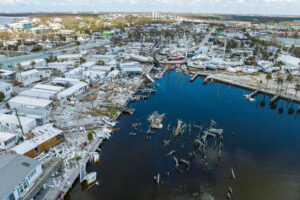OCTOBER 7, 2022

Litigation is looming for home insurers in Florida as cash-strapped, underinsured homeowners—paired with an aggressive plaintiffs’ bar—are expected to turn to the court system to try to force payments for flood damage that the carriers say they aren’t legally obligated to cover.
Fewer than one-third to just over 40% of the Florida homes in the two coastal counties hardest hit by Hurricane Ian are covered by flood policies, although standard homeowners’ policies in the U.S. for decades have excluded flood damage. In some of the inland counties badly flooded by Ian’s torrential rains, only a few out of every 100 homes have flood insurance.
At stake are potentially billions of dollars in proceeds from homeowners’ policies that, if homeowners get their way, could close some of the insurance gap and help people rebuild and repair homes. Insurers say their flooding exclusions are solid and the premiums they charged didn’t bake in responsibility for flooding damage. But determining whether wind or water actually caused the damage isn’t always clear-cut, particularly if just a slab is left.
The stage is set for a potential litigation frenzy akin to the one after Hurricane Katrina devastated parts of Louisiana and Mississippi in 2005, say industry executives, agents and attorneys. Plaintiffs’ lawyers made headway in lower courts, often by challenging restrictive clauses in standard homeowners’ policies dealing with dual wind and flooding damage. They asserted that some wording was ambiguous and should be interpreted in policyholders’ favor.
Ultimately, many insurers prevailed on appeal, but it took years of legal expense, and there were numerous settlements along the way.
The low uptake rate for flood policies “opens the door for immense litigation,” said Barry Gilway, chief executive of Citizens Property Insurance Corp., Florida’s state-run insurer of last resort. “You will have attorneys lined up to take cases in instances when the cause of loss is difficult to determine.”
Randy Maniloff, an insurance-industry lawyer with White and Williams, wrote a note to the firm’s clients last week to alert them to likely lawsuits. “With so much at stake, some of those impacted will see no choice but to turn to the courts in hopes of securing coverage,” Mr. Maniloff said in an interview. “Necessity has long been a driver of creative arguments for insurance coverage.”
Chip Merlin, president of Merlin Law Group in Tampa, Fla., which represents policyholders in conflicts with insurers, said his office already is receiving calls from people who feel their home insurers aren’t treating them fairly. Some say they sought to file a claim but were directed to file with their flood insurer. Mr. Merlin’s stance is that a claim should be filed with both home and flood insurers, to better ensure that damage from both wind and flood is identified and the homeowner can tap into both policies’ proceeds.
“These things often end up in court unfortunately,” Mr. Merlin said. “We’re doomed to go through it again.”
Caught in the middle are homeowners including Ken Dolan in Cape Coral in Lee County, where Ian arrived. The storm blew off the chimney and part of the roof of his ranch house. Water as high as about two feet inside damaged floors, lower sections of walls, furniture and appliances, he said.
His home-insurance policy provides up to $409,000 for the dwelling itself, and $102,000 for personal property. His separate flood policy provides up to $240,000 for the building, but nothing for contents. He said a mold-remediation firm he sought to hire checked with his home insurer, which said it wouldn’t cover the firm’s services if damage was due to rising waters.
“I didn’t realize it was going to be such a challenge, trying to distinguish between the flood and the hurricane damage,” Mr. Dolan said.
Insurers’ adjusters are expected to be looking at such things as marks left by floodwaters on walls and sand on floors to ascertain flooding damage, while assigning responsibility to home insurers for such things as roof replacement and broken upper-story windows.
“You parse out the damage done by wind vs. surge,” said Melissa Burt DeVriese, president of Security First Insurance. “Our adjusters are experienced and can handle ensuring the customer is paid for everything that they are owed under the terms of their policy.”
Especially tricky in Katrina were instances of obliterated properties, known as slab claims. There weren’t wall markings or missing roofs to provide clues. Ian left behind many slabs.
“The house is gone: Did surge wipe it out, or wind?” said Mohsen Rahnama, chief risk modeling officer for catastrophe-modeling firm RMS. He said that estimating the amount that insurers will have to pay out from Ian has been hard to do at this point for a number of reasons, including the role of litigation, as it was with Katrina.
The biggest seller of flood policies to U.S. homeowners is the federal government’s National Flood Insurance Program, with coverage limits of $350,000 for a dwelling and contents. Given rising building and repair costs, some policyholders with flood policies may resort to suing their home insurers, arguing that their losses were caused at least partly by wind, to tap into bigger potential payouts, said Jake Holehouse, president of HH Insurance in St. Petersburg, Fla.
As with Katrina, some insurers are expected to argue that their policies’ “anti-concurrent causation” clauses exclude payouts for wind damage if it occurred in conjunction with flooding, lawyers said. It is unclear how many of those clauses exist in Florida policies.
Meanwhile, an added complication in Florida is that a small subset of home policies exclude not just flooding but wind damage. So homeowners would need not just a separate flood policy but a wind one, too.
Florida’s plaintiffs’ bar is experienced at suing home insurers over disputed claims. Florida represents about 9% of the nation’s homeowners insurance claims, while accounting for 79% of the nation’s homeowners insurance lawsuits over claims, according to the Florida Office of Insurance Regulation.
The litigation has contributed to double-digit premium-rate increases for home insurance in recent years. Florida’s average annual home-insurance premium of $4,231 is among the nation’s highest, according to projections by trade group Insurance Information Institute.
Robert Hartwig, director of the Center for Risk and Uncertainty Management at the University of South Carolina’s business school, believes Ian-related legal disputes are “unavoidable in a state with a trial bar that is already intimately familiar with the homeowners insurance market.” That said, legal precedents established in the Katrina lawsuits will help to “limit where this litigation can go,” he said.
Source /Courtesy: WSJ

































































































